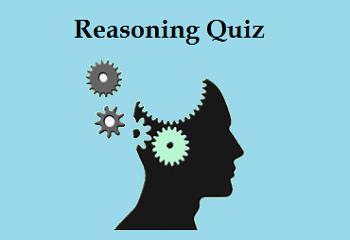Hello Aspirants. Welcome to Online Reasoning Section in AffairsCloud.com. Here we are creating question sample in coded Inequalities, which is common for all the competitive exams. We have included Some questions that are repeatedly asked in bank exams !!
Questions penned by Yogit
Direction: Q(1 – 5)
‘A @ B’ means A Is not smaller than B
‘A # B’ means A is neither smaller than nor equal to B
‘A % B’ means A is neither smaller than nor greater than B
‘A $ B’ means A is not greater than B
‘A * B’ means A is neither greater than nor equal to B
- Statements: – P@Q, Q#R, R%S
Conclusions: – 1) P#R 2) Q#S
1) If only conclusion 1 is true
2) If only conclusion 2 is true
3) If either conclusion 1 or 2 is true
4) If neither conclusion 1 nor 2 is true
5) If both conclusions 1 and 2 are trueAnswer – 5) If both conclusions 1 and 2 are true
Explanation :
P>=Q>R=S (Both conclusion directly follows) - Statements: – P $ Q, Q * R, R % S, S#T
Conclusions: – 1) Q#T 2) R@P
1) If only conclusion 1 is true
2) If only conclusion 2 is true
3) If either conclusion 1 or 2 is true
4) If neither conclusion 1 nor 2 is true
5) If both conclusions 1 and 2 are trueAnswer – 4) If neither conclusion 1 nor 2 is true
Explanation :
P<=Q<R=S>T (we can’t say anything about Q and T and Clearly R is always greater than P) - Statements:- P * Q, Q # K, K $ J, J % T
Conclusions: – 1) T@K 2) P#K
1) If only conclusion 1 is true
2) If only conclusion 2 is true
3) If either conclusion 1 or 2 is true
4) If neither conclusion 1 nor 2 is true
5) If both conclusions 1 and 2 are trueAnswer – 1) If only conclusion 1 is true
Explanation :
P<Q>K<=J=T (First conclusion directly follows while for second conclusion we can’t say anything) - Statements: – P $ W, W % X, X @ K, K*L
Conclusions: – 1) X@L 2) X*L
1) If only conclusion 1 is true
2) If only conclusion 2 is true
3) If either conclusion 1 or 2 is true
4) If neither conclusion 1 nor 2 is true
5) If both conclusions 1 and 2 are trueAnswer – 3) If either conclusion 1 or 2 is true
Explanation :
P <= W = X >= K < L (X will be either greater than or equal to or smaller than L) - Statements: – P $ Q, Q % R, R * S, S # T
Conclusions: – 1) R # T 2) P*S
1) If only conclusion 1 is true
2) If only conclusion 2 is true
3) If either conclusion 1 or 2 is true
4) If neither conclusion 1 nor 2 is true
5) If both conclusions 1 and 2 are trueAnswer – 2) If only conclusion 2 is true
Explanation :
P <= Q = R< S >T (clearly S is greater than P)
Direction: Q(6 – 8)
P % Q means P is not greater than Q
P δ Q means P is neither greater nor smaller than Q
P # Q means P is neither greater nor equal to Q
P $ Q means P is not smaller than Q
P @ Q means P is neither smaller nor equal to Q
- Statements: – P $ Q, Q @R, R δ T
Conclusions: – 1) P @T 2) Q δ T 3) T % Q
1) only one follow
2) only two follow
3) only three follow
4) 1 and 2 follow
5) None of theseAnswer – 1) only one follow
Explanation :
P>=Q>R=T (first directly follows) - Statements: – B@D, D%F, F$C
Conclusions: – 1) F@B 2) CδD 3) C%B
1) only 1 follow
2) only 2 follow
3) either 1 or 3 follow
4)Both 1 and 2 follow
5) none followAnswer – 5) none follow
Explanation :
B>D<=F>C (none follow) - Statements: – AδB, B$C, C%D
Conclusions: -1) B@D 2) DδA 3) A$C
1) Only 1 follow
2) only 2 follow
3) only 3 follow
4) All follows
5) None followAnswer – 3) only 3 follow
Explanation :
A = B >= C <=D (clearly A>=C) - What should be come in the place of question mark to make P always greater than R in the expression P>Q?R<=S=T.
1) =
2) >
3) <
4) <=
5) Both a and bAnswer – e) Both a and b
Explanation :
P>Q=R<=S=T and P>Q>R<=S=T - Which of the following should be place in the blank spaces of the expression P_Q_R_S_T from left to right in order to make P>Q and R>T always true.
1) >, <, >, >=
2) >, >, >=, <
3) >, >=, =, <
4) >, =, <, =
5) None of theseAnswer – 1) >, <, >, >=
Explanation :
P>Q<R>S>=T (P>Q and R>T always follow)



